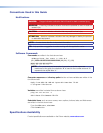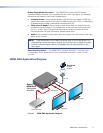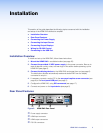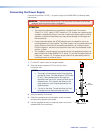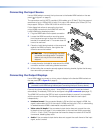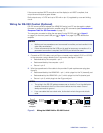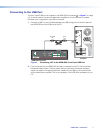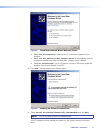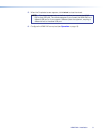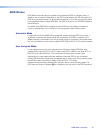
Connecting the Input Source
Use an HDMI cable to connect the input source to the female HDMI socket on the rear
panel (
b
in figure 2 on page 3).
The connectors are fully HDCP compliant. With cables up to 25 feet (7.6 m) they support
resolutions of up to 1080p @ 60 Hz with 12‑bit color. With cables up to 50 feet (15.2 m)
they support 1080p or 1920x1200 @ 60 Hz with 8‑bit color.
Follow these instructions to secure the input and
output HDMI connectors to the HDMIDA2 with the
LockIt HDMI lacing bracket provided:
1. Plug the HDMI cable into the panel connection.
2. Loosen the HDMI connection mounting screw
from the panel enough to allow the LockIt lacing
bracket to be placed over it. The screw does not
have to be removed.
3. Place the LockIt lacing bracket on the screw and
against the HDMI connector, then tighten the
screw to secure the bracket.
ATTENTION: Do not overtighten the HDMI
connection mounting screw. The shield it
fastens to is very thin and can easily be
stripped.
4. Loosely place the included tie wrap around the HDMI
connector and the LockIt lacing bracket as shown.
5. While holding the connector securely against the lacing bracket, tighten the tie wrap,
then remove any excess length.
Connecting the Output Displays
Use a HDMI cable to connect up to two output displays to the female HDMI sockets on
the rear panel (
c
in figure 2 on page 3).
NOTE: Secure the input and output HDMI connectors to the HDMIDA2 with the
provided LockIt HDMI lacing bracket (see Connecting the Input Source, above).
Connect the primary display to output 1 since EDID from output 1 is read and stored
automatically. If necessary, EDID can be configured using SIS commands (see page 17).
The HDMI DA2 monitors the EDID of each connected display to ensure it is compatible
with the current input signal. The following adjustments are made for each output
independently:
z Interface format: If the connected display is DVI and the input signal is HDMI, the
signal is reformatted to DVI. If the output is HDMI and the input is DVI, no reformatting
is needed because HDMI is backwards compatible with DVI.
z Video color bit depth: If the connected output device does not support the color
bit depth of the input signal, it is truncated down to the next level that is supported
(12‑bit>10‑bit > 8‑bit). The signal can be forced to always truncate to 8‑bit via SIS
commands, disabling deep color.
z Audio: If the connected output device does not support the audio format of the input
signal, audio is muted.
3
4
3
1
2
HDMIDA2 • Installation 5




